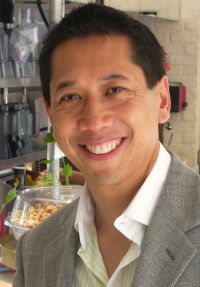 You know that Smooch must be an interesting and fun company when the CEO refers to himself on his business card as Chief Smooch. Marcus Yeung, a Tokyo-based entrepreneur and founder of smoothie pioneer Smooch Japan KK, is certainly having a good time, despite the tough economic conditions.
You know that Smooch must be an interesting and fun company when the CEO refers to himself on his business card as Chief Smooch. Marcus Yeung, a Tokyo-based entrepreneur and founder of smoothie pioneer Smooch Japan KK, is certainly having a good time, despite the tough economic conditions.
Smooch has two stores in Japan – a flagship store at Ebisu Garden Place and a collaboration store with Francfranc in Nagoya. But that is only the beginning. Yeung has plans to get the number up to 50 in the next few years.
Born to a Chinese father and Dutch mother, Yeung grew up in England. After graduating from university, he joined investment bank SG Warburg which sent him to Japan in 1990. After stints in HK and Singapore, he joined The Carlyle Group which brought him back to Japan. He then set up his own investment firm in 2003 partly because he wanted to bring foreign business concepts to Japan. Smooch was established in 2006.
GaijinPot, together with Japan Today editor Chris Betros, visited Yeung at the Smooch store in Ebisu to taste some smoothies and hear more about the business.
What is your main selling point?
We offer healthy and delicious treats in a feel good environment. Most people still think a smoothie is some kind of a shake made with ice cream. That’s one of the biggest challenges we face. We thought that bringing in smoothies would be easy because consumers would get it immediately. But we have had to spend a lot of time trying to educate customers that it’s not just a summer drink, it’s not ice cream, but it is a very healthy and delicious snack made with good things like fruit and yogurt.
Has it been difficult finding the right location?
Yes. It’s all about location and competition for best spots is high. In future, I’d like to have flagship stores in places like Harajuku, Midtown and Lalaport, and satellite stores in shopping centers where we are not subject to the weather.
How are you marketing the brand?
Word of mouth is the best marketing method. We do not pay for advertising. We send out regular press releases and our website is fun and interactive; we’ve got blogs and recipe exchanges. We do promotions on Facebook and Twitter. We also do tastings, go to schools and events, yoga festivals and so on.
We’ve been on about 30 TV morning and lunchtime programs, introducing our smoothies, and our stores have been featured in many magazines which use us for fashion shoots. Ebi-chan (popular model Yuri Ebihara) was here not too long ago. Things like that are good but the best advertisement is the store itself and our friendly staff. Many of our customers are repeaters. Once they taste a smoothie and like it, they build it into their routine and come back with their friends. We’re popular in the gaijin community. We’re possibly the No. 1 afternoon date spot for mixed couples on weekends.
Tell us about the Smooch iPhone app.
It gives customers mobile phone access to all sorts of information on Smooch, our latest promotions and drinks and lets them access our Twitter page and home pages. It also incorporates a stamp card for iPhone using bump technology. This allows customers to get rid of paper point cards and replace it with a point card in their iPhone, which can be updated only at Smooch using the latest GPS and bump technologies. It is quite interactive and customers can post feedback.
What were some of the challenges you faced when you started this business?
Financing is always a huge obstacle in Japan for would-be entrepreneurs. Venture funds in Japan don’t really invest in the first two or three years of a business. Banks don’t lend until your cash flow is positive. So for the first two years you are on your own unless you have angel investors or you use your own money. I used my own money and raised the rest from angel investors.
Next, you have to do your research into the market very carefully. In the movie “Field of Dreams,” Kevin Costner says: “If you build it, they will come.” That doesn’t always apply to businesses in Japan. You have to make sure your product works in Japan and test it thoroughly with consumer group interviews. I was very confident that Japanese consumers would like smoothies, but business was slow to start off. It wasn’t the product, but the way we marketed and represented ourselves to the consumer. We had a rollercoaster time for the first two years and then restructured by closing two stores. Now, I think we are on track with a menu and team that works.
You can check more about the company, here: www.smooch.co.jp . Marcus also shared some more of his insight on business plans for opening up shop in Japan.

